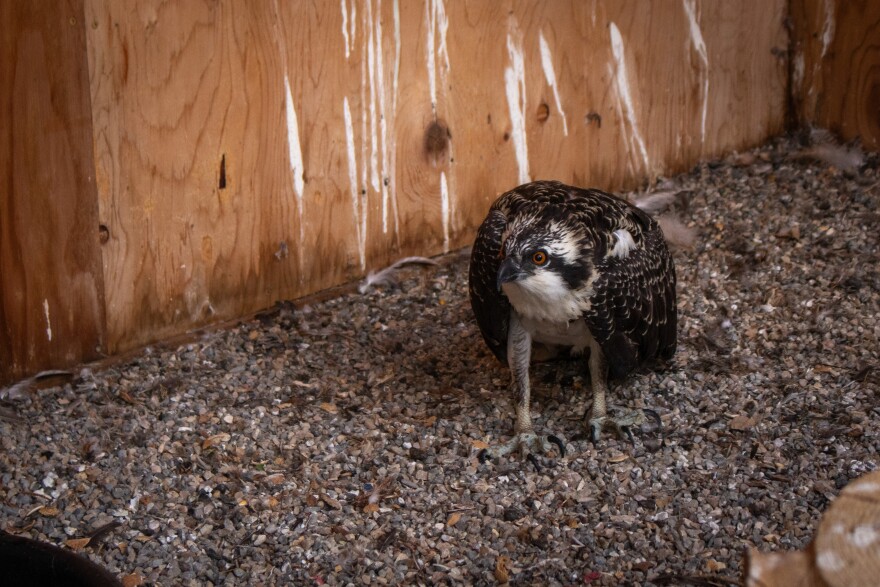The Wildlife Rehabilitation Center of Northern Utah looks like a cross between a veterinarian’s office and a nature center. Kennels are stacked in one room, some with birds recuperating inside. There’s an operating table in the next room. Outside, other birds live in larger enclosures.
The center treats small mammals and birds, including raptors, or birds of prey.
“Eighty percent of what's coming through our door is human impact,” said DaLyn Marthaler, executive director of the Ogden-based center.
That includes birds that were hit by cars or flew into windows.
Education is a priority, so staff talk with people who bring in an animal about the cause of the injuries and how to prevent it from happening in the future.
But weather also plays a role in the patients that come through their doors. Every summer for the past 11 years, including 2025, Salt Lake City’s average temperature from June through August has been higher than the 1991-2020 average. That makes it harder for birds to find food because their prey might not survive, Marthaler said.
“We're seeing these large numbers of starving and emaciated, dehydrated birds,” she said. “That – we just had one come in yesterday. It was a Swainson’s hawk, and she was a fledgling, and she was extremely emaciated and dehydrated. And she was past the point of being able to save her.”

Even after years in this line of work, losing an animal saddens Marthaler. That’s part of why extreme weather concerns her. The center uses its funds carefully, and it’s always tricky to buy the exact amount of supplies they need without anything going to waste. Over the years, she said, they’ve had an idea of what to expect. That’s changing.
Climate change is making extreme weather events more frequent and intense. Hotter temperatures, Marthaler said, are making their calculations harder.
“Someone comes in on Friday night and they need a certain medication, and we don't have it on hand, chances of them surviving the weekend is not good.”
Healthy, mature birds have the advantage of being able to fly to cooler or shadier ground. Younger ones are vulnerable to the heat in their nests, said Steve Slater, conservation science director at the nonprofit HawkWatch International.
“We do have birds that die from exposure,” he said. It’s especially challenging in dry climates far from densely populated areas where humans have planted trees.
Wildfires are another concern. Some owls, for instance, nest inside cavities in trees.
“We have huge tracks of their habitat that gets destroyed in a single fire,” he said.

Birds who have been through rehab, especially those who went in before learning to live on their own, are less likely to survive in the wild than their always-wild peers, Slater said. But enough survive to make rehab “definitely worth doing.”
Even people who’ve never taken a liking to their beaky neighbors should care, he argued, because they provide so-called ecosystem services.
“That's a term we use in science that talks about services that wildlife are providing that humans really care about. Like, we don't like rodents eating our crops.”
Kestrels, for instance, hunt voles and shrews that can damage crops. Swainson’s hawks eat rodents and insects. Raptors — “just one of the coolest animals,” in Slater’s view — also provide clues to the health of the broader landscape and ecosystem.
“Bald eagles and peregrine falcons, back in the ‘70s, were the first ones to really help us understand that DDT was getting into the water and into our own bodies and causing these issues,” he said.
The pesticide was largely banned in the United States in 1972, following the 1962 book “Silent Spring” by Rachel Carson.
Stepping in when it’s not necessary can cause more harm than good, so Slater encourages people to ask an expert what to do if they think they see an injured bird.
“If they absolutely do need an intervention, then of course, rehab and other places are the appropriate place, and we need to support that work.”

In the long term, Slater is most concerned about habitat degradation due to wildfires and drought. Water is not just for people, he said.
But even as temperatures cool off heading into the fall, Marthaler doesn’t expect the job to get any easier.
“We're going to have extreme weather events again,” she said, “whether it's lack of snow or extreme cold or extreme snow.”
Macy Lipkin is a Report for America corps member who reports for KUER in northern Utah.






